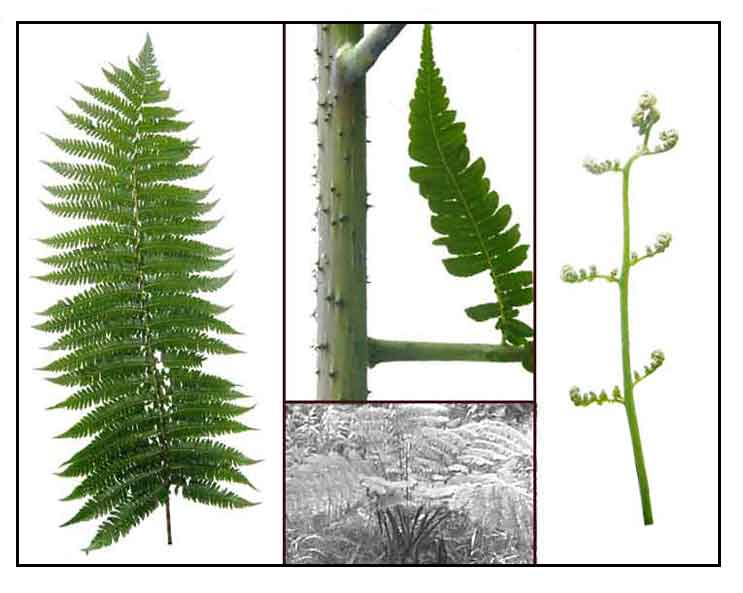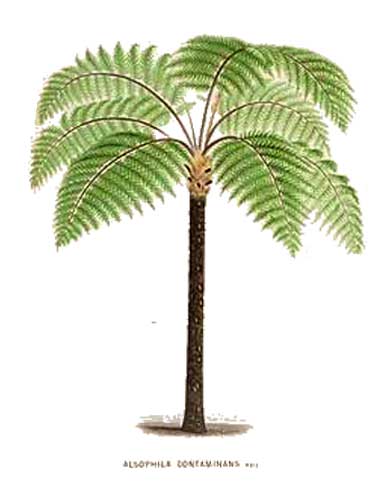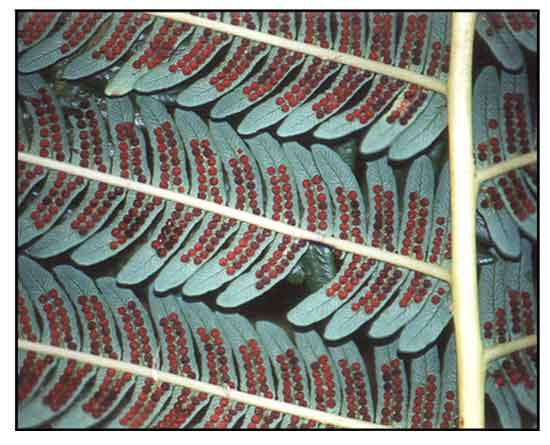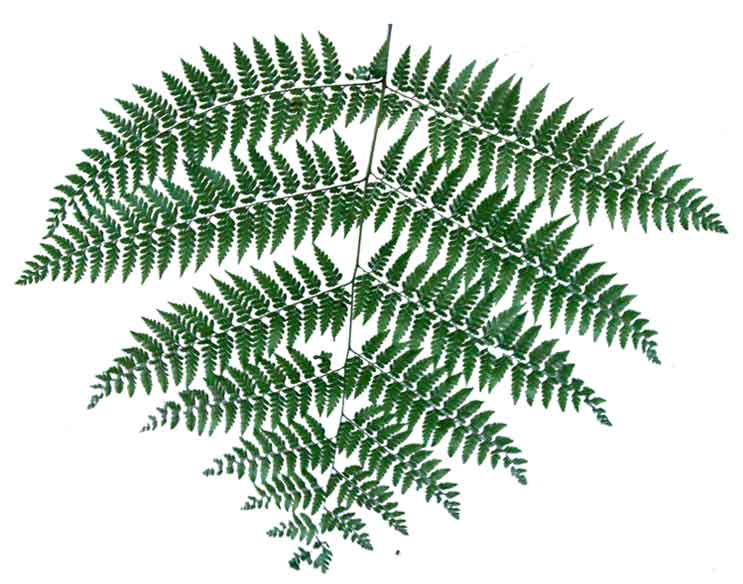 
Gen info
- Sphaeropteris is a genus of tree fern in the family Cyatheaceae. It has been treated as a subgenus in the genus Cyathea, but is accepted in the Pteridophyte Phylogeny Group classification of 2016. Sphaeropteris is now separated from the other genera in the family Cyatheaceae on the bais of molecular phylogenetic studies.(7)
--There are 26 endemic species of Cyathea in the Philippines.
Botany
• Pakong-buwaya is a tree fern that grows to 7 meters. Trunk
is covered with black and still interlacing roots. Leaves are bipinnate
up to 2.5 meters long. Leaf stalk is stout, spiny, and purplish, up to 90
centimeters long, covered with dense scales when young.
• Tall tree fern, up to 10 m or more; scales pale, with blackish setae at edges; stipe, as well large part of rachis, obviously aculeate throughout; lamina 2-pinnate-pinnatifid; pinnae petiolate, alternate; costae and costules abaxially subglabrous or bearing a few scurfy scales and some hairs; veins forked; sori in two rows, close to midribs; indusia lacking. (14)
 Distribution Distribution
- Native to the Philippines.
-
Occasionally planted in Manila gardens,
but grows poorly in low altitudes. Thrives well in the Baguio area.
- Also native to Bangladesh, Borneo, East Himalaya, Laos, Lesser Sunda Is., Malaya, Myanmar, Nicobar Is., Sulawesi, Sumatera, Thailand, Vietnam. (4)
Constituents
- Study isolated a new acylated flavonol glycoside from the fronds of Cyathea contaminans and was chemically characterized as kaempferol-7-(6'-succinyl)- glucoside. (Yamane et al 1985) (6)
- GC-MS analysis of fronds extracts yielded active compounds dominated by 2H-tetrazole, 5-(thiophen-2yl) methyl (14,29 %), 2-thiophene acetic acid, 2-methyl phenyl ester (14,54%), and phenol, 2,6-bis(1,1-dimethyl ethyl)-4-methyl (10.54%).
(see study below) (10)
Propertie
- Studies have suggested antioxidant, antibacterial, phytoindicator, anti-spasm properties
Uses
Edibility
- Young fronds boiled and eaten as vegetable.
- Pith used as famine food. (9)
Folkloric
- In Davao, Mindanao, pounded leaves rubbed on forehead to relieve headaches. (5)
- Sap used by various tribes for treatment of edema,
boils, ulcers, and swollen lymph nodes.
- In Waya, West Fiji, sap of young plants applied externally to cure headaches. (9)
- Indigenous people of the SOCSARGEN Region, topically apply smoked/heated shaved skin of stem to treat epilepsy. (15)
 - In Chinese medicine, rhizome hairs are considered styptic for coagulating
blood. - In Chinese medicine, rhizome hairs are considered styptic for coagulating
blood.
- Used for rheumatic problems.
- Old man's tonic.
- Rhizomes used topically for wounds and ulcers.
- In India, used for wound healing: soft apical portion of caudex is cut into small pieces, crushed in a mortar and made into paste, then applied daily to major cuts and wounds until healed. (3)
Others
- Handicraft and home uses: Stems used for making vases, pots for orchids, and other handicraft products. Trunk use as construction material (fencing posts). Scales used to stuff pillows.
-
Anitos: Wood used for making human-shaped carvings to resemble deities and spirits, much worshipped during colonial times, now persisting more as a symbol of cultural heritage. (8)
- Fiber: Fiber and lathe material.
- Fuel: Dried Anonotong used for firewood or making charcoal.
- Ornamental use.
- Wood: Trunks carved into vases and statues.
- Orchid media: Fibrous trunk used as orchid media or flower stand, which may have contributed to its decline.
- Ceremonial: Charred stem rubbed on forehead of afflicted child to protect against evils. (5)
- Cordillera ritual: In the olden times of Igorots head-hunters, the human head from a neighboring village was used as offering for healing of a sick community member. The ritual has become much less demanding. Currently, the shoot of C. contaminans has become an acceptable ritual offering as a substitute for the head. (12)
Studies
• Flavonol Glucoside: Study isolated a new acylated flavonol glucoside from the fronds, chemically characterized as kaempferol-7-(6"-succinyl)-glucoside and named pteroflavonoloside. (1)
• Phytoindicator / Forecasting Microclimate Changes: Study explored the potential of fern species in landscape ecology, as natural indicators to forecast microclimate changes in the urban area and for application in landscape design. Microclimate and altitude have a strong relationship with the distribution of the fern species. Findings suggest fern species are excellent phytoindicator for unhealthy environment such as harsh urban environment. (2)
• Antioxidant / Antibacterial: Study evaluated the antioxidant and antibacterial activities of polar and non-polar fern extracts of mature fronds, young fronds, and hairs. The methanol extract of mature leaves (fronds) exhibited weak to very strong antioxidant activities (IC50s 37.13 to 255.19 µg/mL) by DPPH assay; hairs and young fronds showed weak activities. Hexane fraction from fronds against E. coli and S. aureus (43.92% and 46.8%) and from hairs against E. coli (48.1%) in concentration of 250 µg/mL. (see constituents above) (10)
• Anti-Spasm Oil: Study evaluated the use of Cyathea contaminans as anti-spasm oil using three formulations: (A) C. contaminans oil 87.5%, lavandula oil 5%, VCO( Virgin coconut oil) 5%, and surfactant 1.25%; (B) 89.0, 5.56, 4.44, 1; and (C) 90, 5, 4, 1. While the formulations showed no significant differences in sensory evaluation of color, aroma, and texture, literature cited and study results considered the anti-spasm oil with 90% C. contaminans content as most effective based on speed and longevity of efficacy. (11)
Availability
- Wild-crafted. |





 - In Chinese medicine, rhizome hairs are considered styptic for coagulating
blood.
- In Chinese medicine, rhizome hairs are considered styptic for coagulating
blood.

